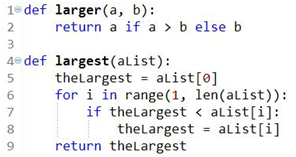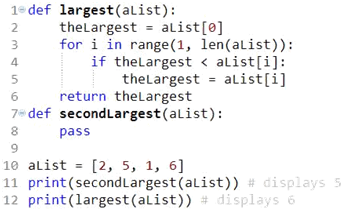Question 1
Use your understanding of the building blocks of computers and programs to answer this question. You are given the following code segments:
(a) 
- Describe how a while statement and how an if statement execute, giving ONE (1)
- Explain in ONE (1) sentence what the code segment does.
- What is the output of the code segment when it is executed?
- How many times is the statement on line 5 executed?
(b) 
- Explain in ONE (1) sentence what the code segment does.
- How many times is the statement on line 3 executed?
- When the code segment is executed, there is no runtime error. Give the output of the code segment.
Question 2
Refer to Appendix A should you need the Python documentation.
(a) 
You are given two functions:
- larger which takes two numbers as arguments, and returns the larger of the two numbers.
- largest which takes a list of numbers as an argument, and returns the largest number in the list.
Rewrite the function largest so that it calls the function larger.
(b) 
You are given the following Python objects:
- A function largest that takes a list of numbers as argument, and returns the largest number in the list.
- A dictionary students with name (e.g., John) as key and mark (e.g., 53) as value
Applying data structures to store and process information, write statements in Python to perform the following tasks:
- Print out the highest mark from the dictionary students, using the function largest in this format: The highest mark is 62
- Print the names of students with the highest mark. Each name is on a separate line. The names are preceded by the header: Top Scorer List.
Top Scorer List
Ann
Tom
- Print the number (or the count) of students with the highest mark in this format: Number of students scoring 62 = 2
(c) 
You are given the function largest which takes a list of numbers as an argument and returns the largest number in the list. Thus, the statement on line 12 will display 6.
Expressing a sequence of statements based on computational logic, define the body of the function secondLargest by replacing the statement pass on line 8 with one or more statements.
The function secondLargest takes a list of numbers as an argument and returns the second largest number in the list such that if the function secondLargest is applied on the list, the statement on line 11 will display 5.
Define the function secondLargest to adhere to the following THREE (3) constraints:
- It must call the function largest.
- It should not contain any selection or loop statement.
- It must not mutate the list.
Question 3
This question requires you to solve computational problems using structured programming. Use the functions randrange and the built-in function, round in your implementation.
| random.randrange(start, stop[, step]) |
| Return a randomly selected element from range(start, stop, step). |
| round(number[, ndigits]) |
| Return number rounded to ndigits precision after the decimal point. If ndigits is omitted or is None, it returns the nearest integer to its input. |
- Write a function getRandomNumber() that takes TWO (2) arguments: a minimum value and a maximum value. The function randomly chooses one integer between the minimum and the maximum values (inclusive of these values), and returns the chosen number.
- Write a function getRandomAverage() that takes THREE (3) arguments: a minimum value and a maximum value, and a number for how many numbers should be chosen randomly between the minimum and maximum values.
The function calls getRandomNumber() repeatedly to get the required number of random numbers, sum them up, and return the average.
- Write a function checkRandomness() that takes FOUR (4) arguments: a minimum value and a maximum value, the number of random numbers required to compute average, and the number of digits precision after the decimal point to round the average. The function performs these tasks:
- Call getRandomAverage() with the minimum and maximum values, and the number of random numbers required, and rounds off the average it obtains from the function call, according to the required precision.
- Compute the average of the minimum and the maximum values, and rounds it off according to the same required precision.
- Display both averages and indicates either the two averages are the same or are different.
Two example outputs where 100 random numbers between 1 and 20 are generated are shown here:
Average of 100 random numbers, 10.4 is different from average of 1 and 20, 10.5
Average of 100 random numbers, 10.5 is the same as average of 1 and 20, 10.5
- Write an application that performs the following tasks:
- Prompt the user for the minimum and maximum values and the precision.
- Repeatedly prompt for the number of random numbers to test.
If the number of random numbers to test is not greater than 0, the application ends. Otherwise, the application calls function checkRandomness() with the user input.
An example run is shown here, with user input underlined,
Enter the minimum value and maximum values, separated by a space: 1 20
Enter number of digits precision after decimal point: 1
Enter number of random numbers to test: 100
Average of 100 random numbers, 11.6 is different from average of 1 and 20, 10.5
Enter number of random numbers to test: 100
Average of 100 random numbers, 10.5 is the same as average of 1 and 20, 10.5
Enter number of random numbers to test: -1
Application ended
Question 4
Employ structured programming principles to develop a program that tracks the claims made for 3 types of car insurance policies, A, B and C.
The program uses a dictionary, insurance with policy type as key and a list of claim amounts as value.
An example content of insurance is shown here:
{‘A’: [], ‘B’: [4150, 5502.25], ‘C’: [4625]}
In the example content of the dictionary insurance,
- no claim has been made for policy type A,
- two claims with the amount $4150 and $5502.25 have been made on policy type B,
- one claim with the amount of $4625 has been made for policy type C.
The application provides this menu to users:
Menu
1. Make A Claim
2. Get Summary
0. Exit
- Write a function claim() for Option 1 with the necessary argument(s), if required. The function prompts for a policy type. If the policy type entered is not A, B, or C, the function should print an error message Invalid policy type.
Otherwise, the function prompts and reads a claim amount. If the claim amount is 0 or less, print an error message Invalid claim amount.
If the claim amount is greater than 0, the function appends the claim amount to the list of claim amounts paid out for that policy type, and prints a message Successful policy claim. Append each successful claim as a line containing the policy type followed by the claim amount, into a file, claims.txt. Example content for claims.txt is shown here:
C 1000.0
A 1200.0
C 500.0
- Write a function summary() for Option 2 with the necessary argument(s), if required. The function prints out a summary of the current content of the dictionary. Refer to the example run for the format of the summary.
- Write a program that repeatedly presents the menu and performs the requested operations until option 0 is chosen. Initialise the dictionary, insurance with three policy types A, B, and C, each starts with an empty list of claim amount.
An example run is shown here, with user input underlined:
Menu
1. Make A Claim
2. Get Summary
0. Exit
Enter option: 1
Enter policy type: D
Invalid policy type
Menu
1. Make A Claim
2. Get Summary
0. Exit
Enter option: 1
Enter policy type: C
Enter claim amount: $1000 Successful policy claim
Menu
1. Make A Claim
2. Get Summary
0. Exit
Enter option: 2
Summary of Policies A, B, C
| Policy | Total Claimed($) | Number of Claims |
| A | 0.00 | 0 |
| B | 0.00 | 0 |
| C | 1000.00 | 1 |
1. Make A Claim
2. Get Summary
0. Exit
Enter option: 1
Enter policy type: C
Enter claim amount: $0 Invalid claim amount
Menu
1. Make A Claim
2. Get Summary
0. Exit
Enter option: 1
Enter policy type: C
Enter claim amount: $500 Successful policy claim
Menu
1. Make A Claim
2. Get Summary
0. Exit
Enter option: 2
Summary of Policies A, B, C
| Policy | Total Claimed($) | Number of Claims |
| A | 0.00 | 0 |
| B | 0.00 | 0 |
| C | 1500.00 | 2 |
1. Make A Claim
2. Get Summary
0. Exit
Enter option: 5 Invalid option
Menu
1. Make A Claim
2. Get Summary
0. Exit
Enter option: 0
Application ended

